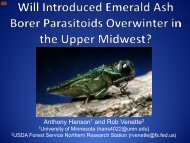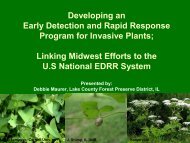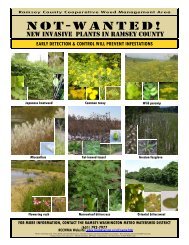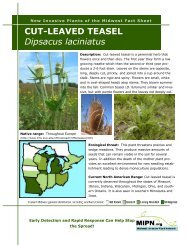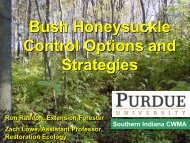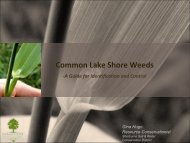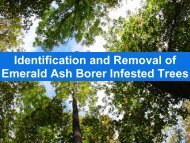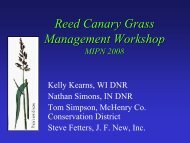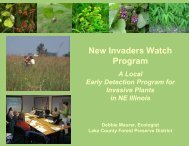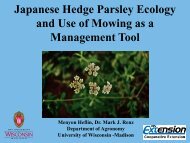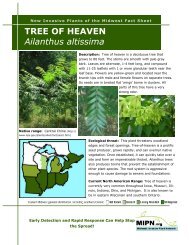The Silent Strangler - Oriental Bittersweet Identification, Biology, and ...
The Silent Strangler - Oriental Bittersweet Identification, Biology, and ...
The Silent Strangler - Oriental Bittersweet Identification, Biology, and ...
Create successful ePaper yourself
Turn your PDF publications into a flip-book with our unique Google optimized e-Paper software.
<strong>The</strong> <strong>Silent</strong> <strong>Strangler</strong> - <strong>Oriental</strong><br />
<strong>Bittersweet</strong> <strong>Identification</strong>, <strong>Biology</strong>,<br />
<strong>and</strong> Risk Assessment<br />
Monika Ch<strong>and</strong>ler, Minnesota Department of Agriculture
<strong>Oriental</strong> bittersweet<br />
Celastrus orbiculatus<br />
• Woody vine that<br />
climbs other<br />
vegetation such trees<br />
<strong>and</strong> structures<br />
• Thrives in a wide<br />
range of habitats, light<br />
levels, <strong>and</strong> soil types<br />
• Grows to 66’ in length<br />
• Introduced as an<br />
ornamental
<strong>Biology</strong><br />
• Reproduces by seed,<br />
rhizome, <strong>and</strong> stolon<br />
• Male <strong>and</strong> female plants<br />
• Fruit production on<br />
female plants<br />
• Seed dispersal is<br />
vectored by birds <strong>and</strong><br />
other wildlife that eat the<br />
fruit containing seed.<br />
• Short-term seed viability
Human vectored dispersal<br />
Urtica/Flickr creative commons
Highly invasive <strong>and</strong> damaging<br />
Vines strangle trees,<br />
reduce light available for<br />
tree growth, <strong>and</strong> added vine<br />
weight can break trees
Amercian bittersweet,<br />
Celastrus sc<strong>and</strong>ens<br />
• Native congener<br />
• Occur in same<br />
habitat<br />
• <strong>Oriental</strong> bittersweet<br />
outcompetes<br />
American<br />
bittersweet<br />
• Hybrids?
Distinguishing bittersweets<br />
American<br />
<strong>Oriental</strong>
Variable Leaf Shape
<strong>Oriental</strong> bittersweet distribution<br />
EDDMapS. 2011. Early Detection & Distribution Mapping System. <strong>The</strong> University of Georgia<br />
- Center for Invasive Species <strong>and</strong> Ecosystem Health. Available online at<br />
http://www.eddmaps.org/; last accessed December 11, 2011.
Risk Assessment<br />
• High invasive potential<br />
– No natural controls<br />
– Grows <strong>and</strong> reproduces quickly<br />
– High propagule pressure <strong>and</strong> vectored dispersal<br />
– Thrives in a wide range of<br />
environmental conditions<br />
• Severe ecosystem threat<br />
• Wildlife food (potential<br />
benefit?)<br />
http://10000birds.com/answers-to-the-diabolicalto-the-extreme-quiz.htm
• Fire concerns<br />
Risk Assessment<br />
– Fuel ladder <strong>and</strong> crown fire<br />
• Potential financial losses<br />
to the forestry sector<br />
• Green industry has<br />
utilized <strong>Oriental</strong><br />
bittersweet but alternatively<br />
can utilize American bittersweet<br />
www.meted.ucar.edu<br />
• Mechanical <strong>and</strong> chemical controls exist<br />
• Regulated in CT, IL, MA, MN, NH, NC, VT, WI
Contact Information<br />
Monika Ch<strong>and</strong>ler, 651-201-6537<br />
MN Dept. of Agriculture<br />
Monika.Ch<strong>and</strong>ler@state.mn.us<br />
MDA’s <strong>Oriental</strong> bittersweet risk<br />
assessment is available at:<br />
http://mnnoxiousweeds.wikispaces<br />
.com/
Other Vines





